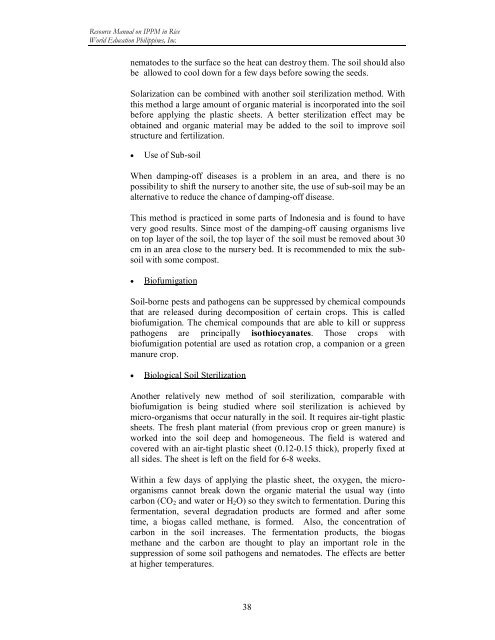(IPPM) in Vegetables - Vegetableipmasia.org
(IPPM) in Vegetables - Vegetableipmasia.org
(IPPM) in Vegetables - Vegetableipmasia.org
You also want an ePaper? Increase the reach of your titles
YUMPU automatically turns print PDFs into web optimized ePapers that Google loves.
Resource Manual on <strong>IPPM</strong> <strong>in</strong> Rice<br />
World Education Philipp<strong>in</strong>es, Inc.<br />
nematodes to the surface so the heat can destroy them. The soil should also<br />
be allowed to cool down for a few days before sow<strong>in</strong>g the seeds.<br />
Solarization can be comb<strong>in</strong>ed with another soil sterilization method. With<br />
this method a large amount of <strong>org</strong>anic material is <strong>in</strong>corporated <strong>in</strong>to the soil<br />
before apply<strong>in</strong>g the plastic sheets. A better sterilization effect may be<br />
obta<strong>in</strong>ed and <strong>org</strong>anic material may be added to the soil to improve soil<br />
structure and fertilization.<br />
· Use of Sub-soil<br />
When damp<strong>in</strong>g-off diseases is a problem <strong>in</strong> an area, and there is no<br />
possibility to shift the nursery to another site, the use of sub-soil may be an<br />
alternative to reduce the chance of damp<strong>in</strong>g-off disease.<br />
This method is practiced <strong>in</strong> some parts of Indonesia and is found to have<br />
very good results. S<strong>in</strong>ce most of the damp<strong>in</strong>g-off caus<strong>in</strong>g <strong>org</strong>anisms live<br />
on top layer of the soil, the top layer of the soil must be removed about 30<br />
cm <strong>in</strong> an area close to the nursery bed. It is recommended to mix the subsoil<br />
with some compost.<br />
· Biofumigation<br />
Soil-borne pests and pathogens can be suppressed by chemical compounds<br />
that are released dur<strong>in</strong>g decomposition of certa<strong>in</strong> crops. This is called<br />
biofumigation. The chemical compounds that are able to kill or suppress<br />
pathogens are pr<strong>in</strong>cipally isothiocyanates. Those crops with<br />
biofumigation potential are used as rotation crop, a companion or a green<br />
manure crop.<br />
· Biological Soil Sterilization<br />
Another relatively new method of soil sterilization, comparable with<br />
biofumigation is be<strong>in</strong>g studied where soil sterilization is achieved by<br />
micro-<strong>org</strong>anisms that occur naturally <strong>in</strong> the soil. It requires air-tight plastic<br />
sheets. The fresh plant material (from previous crop or green manure) is<br />
worked <strong>in</strong>to the soil deep and homogeneous. The field is watered and<br />
covered with an air-tight plastic sheet (0.12-0.15 thick), properly fixed at<br />
all sides. The sheet is left on the field for 6-8 weeks.<br />
With<strong>in</strong> a few days of apply<strong>in</strong>g the plastic sheet, the oxygen, the micro<strong>org</strong>anisms<br />
cannot break down the <strong>org</strong>anic material the usual way (<strong>in</strong>to<br />
carbon (CO 2 and water or H 2 O) so they switch to fermentation. Dur<strong>in</strong>g this<br />
fermentation, several degradation products are formed and after some<br />
time, a biogas called methane, is formed. Also, the concentration of<br />
carbon <strong>in</strong> the soil <strong>in</strong>creases. The fermentation products, the biogas<br />
methane and the carbon are thought to play an important role <strong>in</strong> the<br />
suppression of some soil pathogens and nematodes. The effects are better<br />
at higher temperatures.<br />
38




![Section 4 [ PDF file, 252 KB] - The Field Alliance](https://img.yumpu.com/51387260/1/158x260/section-4-pdf-file-252-kb-the-field-alliance.jpg?quality=85)












